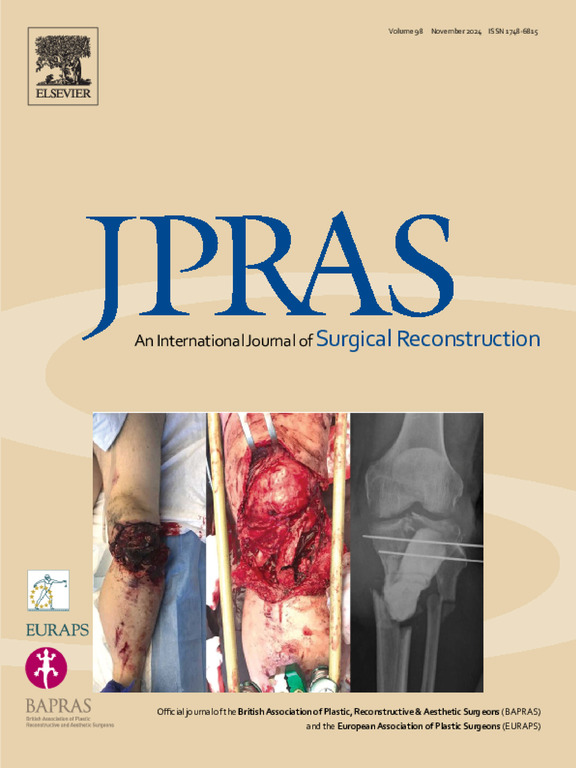改善疾病的抗风湿药物是否会影响自身免疫性结缔组织疾病患者的假体乳房重建结果?
IF 2.4
3区 医学
Q2 SURGERY
Journal of Plastic Reconstructive and Aesthetic Surgery
Pub Date : 2025-08-12
DOI:10.1016/j.bjps.2025.07.042
引用次数: 0
摘要
背景随着隆胸手术的普及,人们对隆胸手术的安全性仍存在担忧。大约8%的美国人患有自身免疫性疾病,然而,比较服用改善疾病的抗风湿药物(DMARDs)和不服用DMARDs的患者进行乳房再造术的结果的文献很少。TrinetX数据库确定了2个队列,每组1262例患者:患有自身免疫性结缔组织疾病的DMARD患者,随后接受了基于植入物的乳房重建术;诊断相似的患者接受了相同的手术,之前没有接触过DMARD。人口统计学和合并症通过1:1的倾向评分分析进行匹配,以确定90天和2年内术后结局的预测因素。结果90 d内DMARD患者出现坏死(OR 1.86, P = 0.03)和手术部位疼痛(OR 1.43, P = 0.01)的几率较高。在2年内,DMARD患者术后感染(OR 1.35, P = 0.04)、DVT (OR 1.76, P = 0.01)、PE (OR 2.52, P = 0.001)、急诊室(ER)就诊(OR 1.21, P = 0.03)、手术部位疼痛(OR 1.46, P = 0.001)和荚膜切除术(OR 1.30, P = 0.04)的几率更高。与使用生物DMARDs的患者相比,使用传统DMARDs的患者在2年内出现囊膜挛缩的几率增加(OR 3.29, P = 0.001)。结论DMARDs患者术后90天和2年内出现不良预后的可能性更大,常规DMARDs患者的包膜挛缩风险增加。整形外科医生应该认识到这些术后并发症,以改善患者的预后。本文章由计算机程序翻译,如有差异,请以英文原文为准。
Do disease-modifying anti-rheumatic drugs affect implant-based breast reconstruction outcomes in patients with autoimmune connective tissue disease?
Background
As breast implants gain popularity, there remains concern over implant safety. Roughly 8% of the U.S population lives with an autoimmune disease, yet there is a paucity of literature comparing outcomes between patients taking disease-modifying anti-rheumatic drugs (DMARDs) and those not taking DMARDs undergoing implant-based breast reconstruction.
Methods
The TrinetX database identified 2 cohorts of 1262 patients each: those with an autoimmune connective tissue disease on a DMARD, and subsequently underwent implant-based breast reconstruction, and those with similar diagnoses undergoing the same procedure, without prior exposure to DMARDs. Demographics and comorbidities were matched via a 1:1 propensity-score analysis to identify predictors of postoperative outcomes within 90-days and 2-years.
Results
Within 90 days, DMARD patients had higher odds of necrosis (OR 1.86, P = 0.03) and surgical site pain (OR 1.43, P = 0.01). Within 2 years, DMARD patients had higher odds of postoperative infection (OR 1.35, P = 0.04), DVT (OR 1.76, P = 0.01), PE (OR 2.52, P = 0.001), emergency room (ER) visit (OR 1.21, P = 0.03), surgical site pain (OR 1.46, P = 0.001), and capsulectomy (OR 1.30, P = 0.04). Patients on conventional DMARDs were found to have increased odds of capsular contracture within 2 years compared to patients on biologic DMARDs (OR 3.29, P = 0.001).
Conclusion
Patients on DMARDs were more likely to experience negative postoperative outcomes within 90 days and 2 years, with increased capsular contracture risk in those taking conventional DMARDs. Plastic surgeons should be cognizant of these postoperative complications to improve patient outcomes.
求助全文
通过发布文献求助,成功后即可免费获取论文全文。
去求助
来源期刊
CiteScore
3.10
自引率
11.10%
发文量
578
审稿时长
3.5 months
期刊介绍:
JPRAS An International Journal of Surgical Reconstruction is one of the world''s leading international journals, covering all the reconstructive and aesthetic aspects of plastic surgery.
The journal presents the latest surgical procedures with audit and outcome studies of new and established techniques in plastic surgery including: cleft lip and palate and other heads and neck surgery, hand surgery, lower limb trauma, burns, skin cancer, breast surgery and aesthetic surgery.

 求助内容:
求助内容: 应助结果提醒方式:
应助结果提醒方式:


